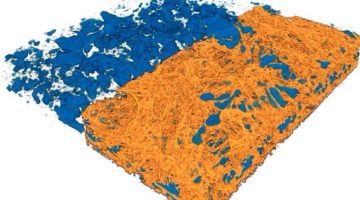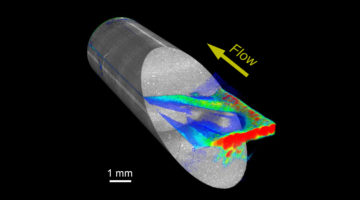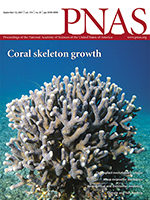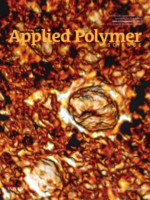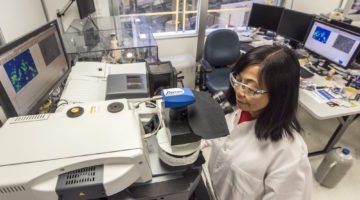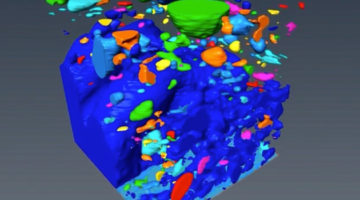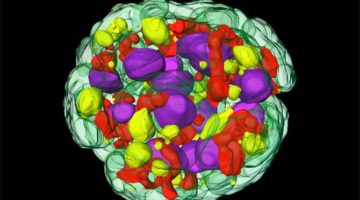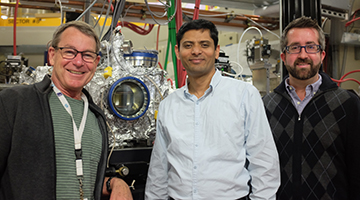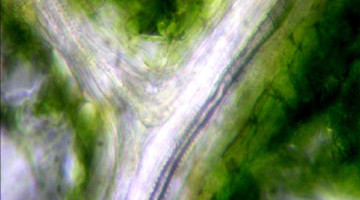A specialized type of hydrogen fuel cell requires precise temperature and moisture controls to be at its best. But seeing inside a working fuel cell at the tiny scales relevant to a fuel cell’s chemistry and physics is challenging, so scientists used x-ray-based imaging techniques to study their inner workings. Read more »
ALS Work Using Microscopy/Imaging
These techniques use the light-source beam to obtain pictures with fine spatial resolution of the samples under study and are used in diverse research areas such as cell biology, lithography, infrared microscopy, radiology, and x-ray tomography.
Fracture Evolution in Carbonate-Rich Shale
Accurate assessment of the suitability of subsurface rock formations for CO2 containment requires a good understanding of fracture evolution. Researchers combined x-ray microtomography with advanced computer simulations to improve models of fracture development in carbonate-rich shale samples. Read more »![]()
![]()
Electrical Switching of Magnetic Vortex Circulation
Photoemission electron microscopy (PEEM) experiments have demonstrated that the circulation direction of a magnetic vortex can be switched by the application of an electric field, opening the door to digital devices with more streamlined system designs, improved performance, and greater energy efficiency. Read more »![]()
![]()
Amorphous calcium carbonate particles form coral skeletons
Skeletons of Stylophora pistillata corals form by the attachment of amorphous calcium carbonate precursor particles, formed within the coral tissue, to the coral skeleton surface. This mechanism is faster than the precipitation of ions from solution and may render the corals less susceptible to ocean acidification than previously assumed. Read more »
In Situ Electrical Resistance and X-Ray Tomography Study of Copper–Tin Polymer Composites during Thermal Annealing
In situ electrical conductivity and x-ray tomography experiments were conducted on a conductive polymer composite containing polyvinylidene fluoride (PVDF) copolymer, copper (Cu), and tin (Sn) during thermal annealing. This study provides detailed insight into the morphological origins of the beneficial effect of thermal annealing on the electrical properties of conductive composites containing low melting metal fillers. Read more »
What’s On Your Skin? Archaea, That’s What
It turns out your skin is crawling with single-celled microorganisms—and they’re not just bacteria. A study by Berkeley Lab and the Medical University of Graz has found that the skin microbiome also contains archaea, a type of extreme-loving microbe, and that the amount of it varies with age. Read more »
How X-rays Helped to Solve Mystery of Floating Rocks
Some rocks can float on water for years at a time before eventually sinking. X-ray microtomography studies help explain how by scanning samples of lightweight, glassy, and porous volcanic rocks known as pumice stones. Their surprisingly long-lived buoyancy can help scientists discover underwater volcano eruptions. Read more »
Sequencing of Green Alga Genome Provides Blueprint to Advance Clean Energy, Bioproducts
Scientists have sequenced the genome of a green alga that has drawn commercial interest as a strong producer of quality lipids for biofuel production. The chromosome-assembly genome of Chromochloris zofingiensis provides a blueprint for new discoveries in sustainable biofuels, antioxidants, and other valuable bioproducts. Read more »
COSMIC Achieves First Light
On Wednesday, March 29, the COherent Scattering and MICroscopy (COSMIC) Beamline (7.0.1) achieved first light, a significant milestone in the ALS’s plans to capitalize on recent gains in soft x-ray coherence provided by modern storage-ring light sources. Read more »
3D Visualization of Leaves during Drought
The veins of living leaves at increasing levels of drought stress were visualized using x-ray microtomography. The results expand our view of leaf drought responses, beyond the traditional embolism-centric view, to a broader focus on the role of the surrounding living tissues in water movement during drought. Read more »
- « Previous Page
- 1
- …
- 13
- 14
- 15
- 16
- 17
- …
- 19
- Next Page »
